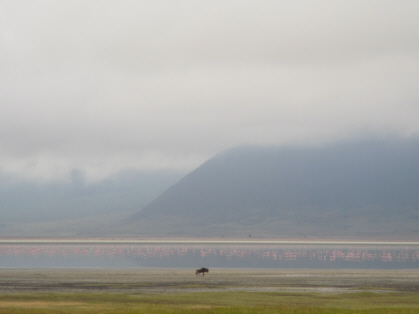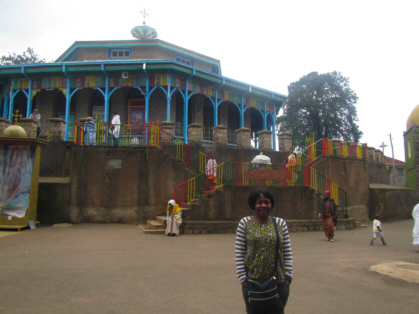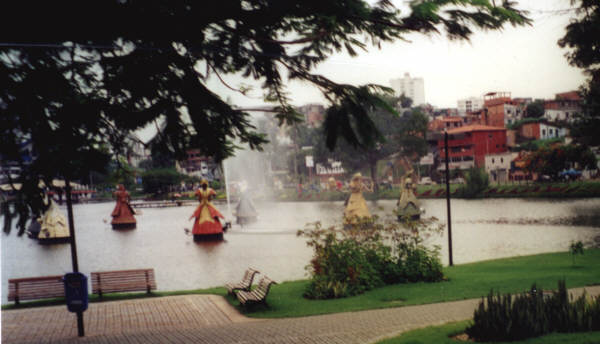Cape Town (continued)
At the conclusion of the tour, our guide gave each passenger the option of being dropped off back at their hotel or at the V&A (Victoria & Alfred) Waterfront. The six of us chose the waterfront. The V&A Waterfront reminds me of a mixture between Fisherman's Wharf in San Francisco and the Baltimore Inner Harbor. There are so many stores here that it would probably take a person several days to visit all of them. Very good street performers keep the tourists entertained while scores of restaurants keep people fed. The six of us had lunch at an outdoor cafe called Rootis as we made plans for the rest of our day.
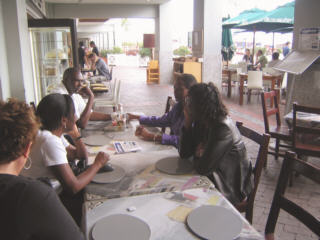
planning our evening over lunch at the V&A Waterfront
Robben Island
Robben Island has served as a leper colony between 1836 and 1931 and later as a maximum security prison until 1991. South Africa's former president and Nobel Peace Prize winner, Nelson Mandela, spent 18 years of his 27-year sentence in a tiny cell on this island.
Robben Island is a very popular attraction. Traci and I were fortunate to get tickets to the island on the same afternoon of our only leisure day in Cape Town. Jeffrey, Patricia, Susan, and Stephanie had made a stop in an art store and said they would meet us at the ticket counter. Unfortunately, by the time they arrived the tour was sold out for the day. Since they were staying in Cape Town a little longer than Traci and I, they had the option of purchasing tickets for another day.
The ferry boat ride to the island takes about a half hour. Once there, there are two parts to the tour: the island tour which takes you around the island in a school bus and the prison tour which walks you through the prison. You find out which tour you are doing first when you get to the island. Basically, if you get off the boat and find that all of the school buses are full then that means you are doing the prison tour first. This was the case for Traci and me.
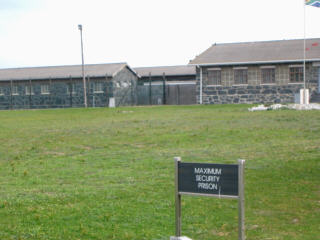
Robben Island Maximum Security Prison
The prison tour begins with everyone taking the same walk from the dock to the prison as every new inmate did when the prison was in operation. Inside, we met our tour guide, Len. Len spent six and a half years as a prisoner on Robben Island. He walked us through the various sections of the prison while explaining the hardships he and other inmates endured here. We learned about the bucket system in which each inmate was given a bucket that he was expected to use as a toilet, a bath, and laundry wash. The cells are small and originally had no windows to shield them from the weather. The cells did not have beds initially. Instead, there was a sleeping mat on the floor. Len told us about the changes he saw during his time there such as the bucket system being replaced by a community bathroom and glass windows being installed over the bars to shield the prisoners from the elements.
We were shown the tiny cell in which Nelson Mandela spent 18 years. With the exception of his cell, we were given time to wander in and out of other cells. They all looked the same; however, each one had a picture of the former inmate along with a small memoir or anecdote. Finally, Len showed us his cell and told us his story of how his involvement with the ANC (African National Congress) led to his conviction of treason and a sentence of 25 years. He served six and a half of those years before being released.

Len, our guide, is a former Robben Island political prisoner.
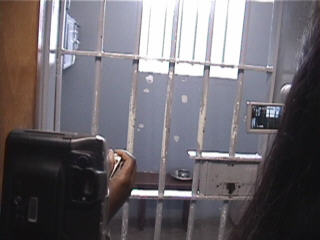
Nelson Mandela spent 18 years in this cell.
After our 45-minute tour of the prison, we boarded a school bus for our circle tour of Robben Island. Our tour guide for this portion of our visit was another former prisoner named Shadiq. Our bus driver (I don't remember his name.) was not a former prisoner; however, he was one of the students injured in the 1976 uprising in Soweto in which 13 year old Hector Pieterson was killed by police. Just as the Rosa Parks incident is seen as the spark that ignited the Civil Rights Movement in the U.S., the killing of Hector Pieterson is seen as the major catalyst for the movement to end apartheid in South Africa.
Our tour guide and bus driver took turns narrating our hour long trip around the island. We were shown sites such as the remnants of a leper colony, the solitary confinement chambers of inmates, the quarry in which prisoners were forced to work 8 hours per day in order to break their will, and the community in which the current residents of Robben Island live. Ironically, former prisoners such as Len, now live in harmony in this neighborhood with former wardens. The former inmates told us it was the non-violent and forgiving attitude of Nelson Mandela that has helped them get over the resentment they had of being imprisoned.
One other thing we noticed during our ride around the island is the wildlife. There are rabbits everywhere. We also saw antelope on the uninhabited side of the island. We even saw a colony of penguins.
Our visit to Robben Island, including the ferry boat rides, lasted three and a half hours. It was one of the highlights of my time in Cape Town. I've visited many museums in which you see exhibits and read the posted information; however, to be guided by people who actually lived the history makes the experience far more moving and educational. I was humbled by this tour.
Evening At The Waterfront
As Traci and I exited the Robben Island ferry, we were greeted by our travel companions who were weighted down with bags after a very successful day of shopping at the V&A Waterfront. It was now early evening and the city lights were beginning to illuminate and shimmer off the water. The shadow of Table Mountain was standing majestically in the background. A mild, light breeze completed this dreamy scene. It was a moment I wish I could save in a bottle and re-open anytime I'm having a bad day.
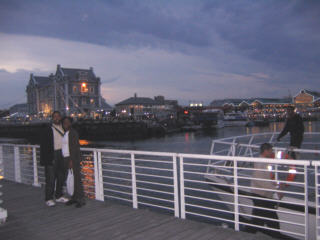
beautiful evening for a stroll
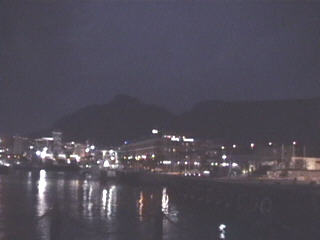
lovely night at the waterfront
The six of us did our regular evening routine of deciding what we had a taste for and where we wanted to eat. We eventually settled on one of the waterfront steakhouses called Belthazar. The food here did not disappoint. We also had a great time sharing the highlights of our day with each other over our meal.
Our taxi ride back to our hotel was full of drama. I thought we were going to witness a Friday Night Smackdown between the driver of our taxi van and a security guard. These two were having a heated argument in a language I didn't recognize. The other taxi drivers stepped in and broke up the dispute when it looked like the two were going to come to blows. Once in the van, our driver gave us a white-knuckle ride that was well over the speed limit. He kept us somewhat distracted by showing a DVD of one of the PBS specials that features 70's groups. We watched performances by the Trampps and Heatwave during our 10 minutes of terror. I was happy to step out of that van in one piece.
